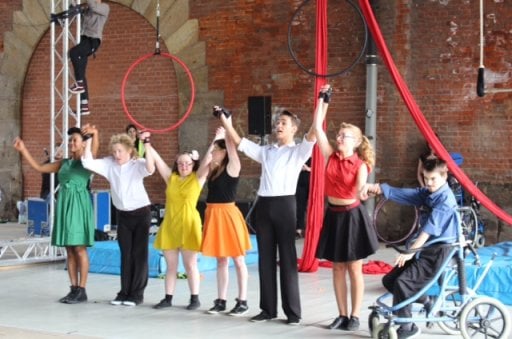
Photo: Alice Chutter
From participant to professional
There have been very few progression routes in the performing arts for young, disabled people who want to make a career in the arts, but Claire Hodgson is aiming to change that.
On Friday 5 September Diverse City’s youth company Remix Gold performed a new aerial circus show called ‘Touched’ at the Southbank Centre as part of the Unlimited Festival. A week later we presented the same piece as part of Activate's Inside Out Festival in Dorset. In both settings our integrated company, comprising non-disabled and disabled young people with learning disabilities and physical impairments aged 15 to 24, were presenting their work as part of a professional arts festival. We aim to place our work in high-profile settings where mainstream audiences will see it. We believe that placing work in these contexts will bring about change and ultimately lead to the full integration of disabled people within the performing arts. This is not without risk, and the response we have received from critics and audiences is interesting.
Take, for example, my experience of working on the opening show for the Olympic sailing events. When our company of 64 young disabled people from Dorset and Brazil walked on to the stage they were met immediately by a huge round of applause from the 11,000 people in the audience. At that point they hadn't actually done anything. As the audience realised that the young people were indeed the protagonists of the show – dancing, singing and performing aerially off a 20-foot crane – there was a perceptible shift. The audience vox pops we collected after the show were overwhelmingly positive about the inclusion of disabled performers.
A paradox is that our young people can have a platform at the Southbank but many struggle to be accepted on further or higher education courses
Similarly, last year I created a show in Ireland in collaboration with choreographer Emma Martin for the historic ballroom in Castletown House as part of the Big House Festival. The show featured 20 learning-disabled performers and, as the title ‘Come dance with me’ suggests was based on a mutual love of ballroom and competitive dancing between cast and choreographers. Perhaps because the festival's marketing did not mention that the performers were disabled, there was a distinct double-take as the show began and the audience realised that all 20 performers were learning-disabled. One reviewer described the first moments as uncomfortable before going on to praise the piece.
Many learning-disabled artists have complained that their work is not programmed and when it is they do not receive a critical response. It seems reviewers and indeed audiences in general simply do not know what to say. This is occasionally because reviewers do not feel they have a hold on the right language. In fact, I have actually been asked to check a reviewer’s work to make sure they were using the right language pre-publication when the review was not particularly favourable to us. The Creative Minds conference in Bristol on 14 October organised by learning-disabled artists aims to tackle this head on by challenging critics and audiences to begin to respond to their work as they would any other piece. They want to open up discussions around quality and for work to be seriously reviewed.
I am talking about two things here: participatory work on public platforms and disability arts. A large percentage of disability art is professional work – and a long and distinguished struggle made that happen. However, I would argue that if as an artist you are working primarily with a particular identity group, perhaps in terms of ethnicity, gender, sexuality, socio-economic disadvantage or disability, you are more likely to see the professional and participatory boundaries as rather blurred. You become involved in your supply chain of future performers because you are not recruiting performers through the normal channels, due to the lack of access to professional training. A paradox is that our young people can have a platform at the Southbank but many struggle to be accepted on further or higher education courses. Our Remix Gold performers wanted to know if they could become professional artists so we have launched the Diverse Futures website to highlight the 375 training, development and employment opportunities for disabled performers across the UK. These are not community or first engagement with the arts opportunities, but rather progression routes in music, dance, theatre and circus for young, disabled people who want to make the arts their career. The 'Pioneers' section on the website has case studies of artists and practitioners who are revolutionising further and higher education.
Participatory art has the potential to develop aesthetics within artforms and to challenge audiences, telling stories and highlighting identities not often heard and seen. As an artist it is my chosen aesthetic. I like how it looks – it engages me in subtle and complex ways – and it makes me feel something. Like all performance, participatory work is sometimes very good and sometimes not good enough. When people ask me if I work in participation or professional contexts, I say I do both at the same time. However, what is clear to me after the last couple of festivals is that there are audiences who welcome participatory work within a programme. I am asking for two things: that all work is reviewed and that participatory work is programmed – and paid for by audiences and programmers. Participatory work needs to be recognised with the status it deserves because it is where innovation and new voices are nourished.
Claire Hodgson is Founder and Director of Diverse City.
www.diversefutures.org.uk
Join the Discussion
You must be logged in to post a comment.